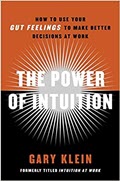Let me precede my discussion of The Power of Intuition by explaining my understanding of the nature of “intuition.” An “intuition” is just a thought, produced by the automatic (subconscious) integration of present observations with past experiences. Qua “intuition,” the basis of the integration is not immediately obvious. That is, what is not obvious is the actual connection being made between past experience and present observation. The thought appears to come from nowhere.
Klein’s view of what “intuition” is and how to use it is in basic agreement with my understanding. In his words, “intuition” is “not a mystical gift” but a “rational and direct outgrowth of experience.” He says that the experience allows you to recognize what’s happening and/or what to do; the recognition is what we call “intuition.” He explains that “intuition” is not infallible, but that once you’ve recognized the situation, you can then quickly and efficiently verify whether your “intuition” is correct. If it is, you can act on it, and in fact you can act much faster than if you had used a completely analytical process.
For example, Klein described how a neo-natal ICU nurse had an “intuition” that a preemie had developed sepsis (a deadly infection). She then examined the baby and checked the baby’s records, and found confirming evidence. She called the doctor and the baby went on antibiotics immediately. She had recognized a complex pattern of subtle physical symptoms; her fast action saved the baby’s life.
The goal of The Power of Intuition is to help you develop your “intuition”—your ability to quickly recognize situations and action opportunities. Klein makes the case that you can do this by analyzing your experience and giving yourself practice exercises to build more experience.
I put this book on the “Thinking Tactics” reference list, because Klein’s methods use the kind of active thinking I teach in my course. He suggests some excellent thinking exercises. For instance, he recommends using a “pre-mortem” exercise when planning a project: after the plan is set, pretend you can look into a crystal ball and see that the project ended in a complete fiasco. Then ask yourself, what happened? Why was it such a disaster? This imaginative approach will help you bring out all the potential problems that you can envision.
Ironically, the exercises are the reason I recommend the book to my students, and the reason I don’t recommend the book to people who haven’t taken my course. The exercises are very hard.
For example, in Chapter 4, Klein recommends making a “Decision Requirements Table” to evaluate and develop better “intuitions” regarding a “critical, difficult, or frequent decision or judgment.” Here are the questions you need to answer to fill in the table:
- What makes this decision difficult?
- What kinds of errors are often made?
- How would an expert make this decision differently from a novice? (Identify cues and strategies.)
- How can you practice and get feedback to help you make this decision next time? (From The Power of Intuition, p. 41.)
These are great questions. Hard questions. How do you answer them? Klein assumes that you have a group with some experts, and can answer the hard questions by means of discussion. That’s fine if it works. But when I tried to use this method by myself to analyze my decisions about priorities, I found it rather difficult. I needed the tools from my own course, particularly “thinking on paper,” surveying, generating alternatives, and diagnosing floundering, in order to make progress. The exercises are good, but they require tackling some hard thinking.
I am comfortable recommending this book to my students, who have the tools to extract its value. Moreover, they might find it useful to go through the book in order to practice the skills learned in “Thinking Tactics.”
For those who haven’t—it is still a good book. Some advice: when answering questions for yourself, use the quickie technique I recommended in a tip on the site. Simply give yourself 3 minutes to try to answer each question on paper. For more advice on “thinking on paper,” see my Thinker’s Toolkit.
Book Information: Gary Klein, The Power of Intuition, Doubleday Business, 2004.









0 Comments